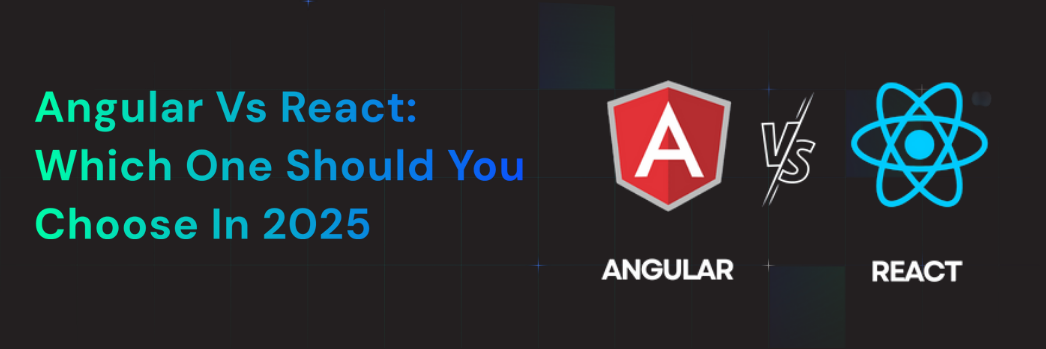In the ever-evolving world of web development, choosing the right front-end framework is crucial. With several options available, two frameworks consistently stand out: Angular vs React. Both have their unique strengths, making it challenging for developers and businesses to decide which one to use. In this article, we’ll break down the key differences, advantages, and use cases of Angular vs React in 2025 to help you make an informed choice.
Angular is a TypeScript-based open-source framework developed by Google. It is a complete solution for building dynamic, single-page applications (SPAs) with a strong structure and built-in functionalities.
Key Features of Angular:
- Two-Way Data Binding: Synchronizes data between the model and the view automatically.
- Dependency Injection: Improves modularity and testability.
- Component-Based Architecture: Enhances reusability and maintainability.
- Built-in Routing: Facilitates smooth navigation within SPAs.
- Comprehensive CLI (Command Line Interface): Simplifies development and deployment.
React is a JavaScript library developed by Facebook (now Meta) for building user interfaces, particularly for SPAs where performance and flexibility are key.
Key Features of React:
- Virtual DOM: Enhances performance by updating only changed components.
- Component-Based Architecture: Enables efficient code reusability.
- One-Way Data Binding: Ensures a more controlled data flow.
- React Hooks: Simplifies state management.
- Strong Community Support: Wide adoption with numerous libraries and tools available.

| Feature | Angular | React |
| Type | Framework | Library |
| Language | TypeScript | JavaScript/JSX |
| Learning Curve | Steeper due to TypeScript and complexity | Easier to learn and implement |
| Performance | Slightly slower due to two-way data binding | Faster due to Virtual DOM |
| Scalability | Highly scalable for enterprise apps | Scalable but requires third-party tools |
| Community Support | Strong but smaller than React | Larger community and ecosystem |
- You are developing a large-scale enterprise application.
- You need a structured framework with built-in solutions.
- Your team prefers TypeScript over JavaScript.
You require robust security and maintainability.
- You need a lightweight, flexible library for UI development.
- You want high-performance applications with a Virtual DOM.
- Your team is comfortable with JavaScript and JSX.
You need a fast, interactive UI with component reusability.
With the growing demand for modern web development, both frameworks will continue to evolve:
- Angular: Expected to introduce more streamlined features and improved performance.
- React: Likely to focus on server-side rendering (SSR) improvements and better state management solutions.
Ultimately, the choice between Angular vs React depends on your project’s needs, team expertise, and long-term goals. If you’re looking for structured, large-scale application development, Angular is the right choice. If you need a lightweight, high-performance UI library, React is your best bet.
If you’re interested in building a web development project with either Angular or React, feel free to contact us at Digital Auxilio for expert guidance and development services!
Search
Recent Post
- How to Choose the Right Mobile App Development Company in India
- Why Indian App Developers Are the Top Choice for Startups
- Expert ASO Services to Boost App Visibility & Organic Ranking
- 7 Essential Types of Digital Marketing Every Business Should Know
- Transform User Experience with Custom Mobile App Solutions
- Custom-Built or SaaS eCommerce: Find the Perfect Platform for Your Business Growth
Categories
- Blog (46)
- Mobile App (12)
- option1 (1)
- option2 (1)
- WordPress (2)




